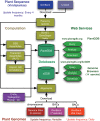PlantGDB: a resource for comparative plant genomics
- PMID: 18063570
- PMCID: PMC2238959
- DOI: 10.1093/nar/gkm1041
PlantGDB: a resource for comparative plant genomics
Abstract
PlantGDB (http://www.plantgdb.org/) is a genomics database encompassing sequence data for green plants (Viridiplantae). PlantGDB provides annotated transcript assemblies for >100 plant species, with transcripts mapped to their cognate genomic context where available, integrated with a variety of sequence analysis tools and web services. For 14 plant species with emerging or complete genome sequence, PlantGDB's genome browsers (xGDB) serve as a graphical interface for viewing, evaluating and annotating transcript and protein alignments to chromosome or bacterial artificial chromosome (BAC)-based genome assemblies. Annotation is facilitated by the integrated yrGATE module for community curation of gene models. Novel web services at PlantGDB include Tracembler, an iterative alignment tool that generates contigs from GenBank trace file data and BioExtract Server, a web-based server for executing custom sequence analysis workflows. PlantGDB also hosts a plant genomics research outreach portal (PGROP) that facilitates access to a large number of resources for research and training.
Figures



Similar articles
-
Genomic and genetic database resources for the grasses.Plant Physiol. 2009 Jan;149(1):132-6. doi: 10.1104/pp.108.129593. Plant Physiol. 2009. PMID: 19126704 Free PMC article. Review. No abstract available.
-
PlantGDB, plant genome database and analysis tools.Nucleic Acids Res. 2004 Jan 1;32(Database issue):D354-9. doi: 10.1093/nar/gkh046. Nucleic Acids Res. 2004. PMID: 14681433 Free PMC article.
-
Comparative plant genomics resources at PlantGDB.Plant Physiol. 2005 Oct;139(2):610-8. doi: 10.1104/pp.104.059212. Plant Physiol. 2005. PMID: 16219921 Free PMC article.
-
GeneSeqer@PlantGDB: Gene structure prediction in plant genomes.Nucleic Acids Res. 2003 Jul 1;31(13):3597-600. doi: 10.1093/nar/gkg533. Nucleic Acids Res. 2003. PMID: 12824374 Free PMC article.
-
Mitochondrial Disease Sequence Data Resource (MSeqDR): a global grass-roots consortium to facilitate deposition, curation, annotation, and integrated analysis of genomic data for the mitochondrial disease clinical and research communities.Mol Genet Metab. 2015 Mar;114(3):388-96. doi: 10.1016/j.ymgme.2014.11.016. Epub 2014 Dec 4. Mol Genet Metab. 2015. PMID: 25542617 Free PMC article. Review.
Cited by
-
Detailed analysis of putative genes encoding small proteins in legume genomes.Front Plant Sci. 2013 Jun 20;4:208. doi: 10.3389/fpls.2013.00208. eCollection 2013. Front Plant Sci. 2013. PMID: 23802007 Free PMC article.
-
Comparative Profiling of microRNA Expression in Soybean Seeds from Genetically Modified Plants and their Near-Isogenic Parental Lines.PLoS One. 2016 May 23;11(5):e0155896. doi: 10.1371/journal.pone.0155896. eCollection 2016. PLoS One. 2016. PMID: 27214227 Free PMC article.
-
Characterization of microsatellites and gene contents from genome shotgun sequences of mungbean (Vigna radiata (L.) Wilczek).BMC Plant Biol. 2009 Nov 24;9:137. doi: 10.1186/1471-2229-9-137. BMC Plant Biol. 2009. PMID: 19930676 Free PMC article.
-
Genomic and genetic database resources for the grasses.Plant Physiol. 2009 Jan;149(1):132-6. doi: 10.1104/pp.108.129593. Plant Physiol. 2009. PMID: 19126704 Free PMC article. Review. No abstract available.
-
Genome-Wide Association Analyses Reveal the Importance of Alternative Splicing in Diversifying Gene Function and Regulating Phenotypic Variation in Maize.Plant Cell. 2018 Jul;30(7):1404-1423. doi: 10.1105/tpc.18.00109. Epub 2018 Jul 2. Plant Cell. 2018. PMID: 29967286 Free PMC article.
References
-
- Altschul SF, Gish W, Miller W, Myers EW, Lipman DJ. Basic local alignment search tool. J. Mol. Biol. 1990;215:403–410. - PubMed
Publication types
MeSH terms
Substances
LinkOut - more resources
Full Text Sources
Other Literature Sources

